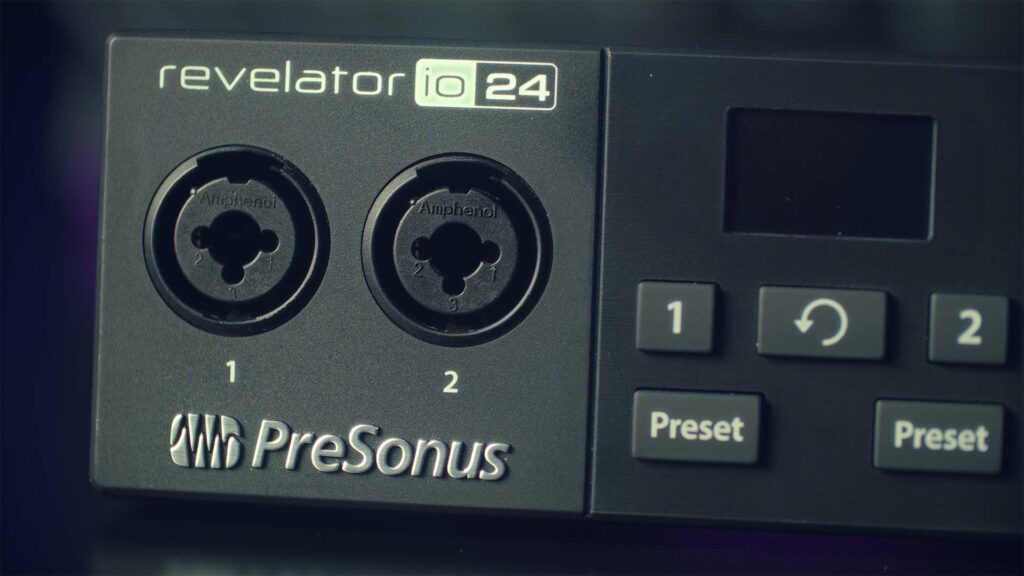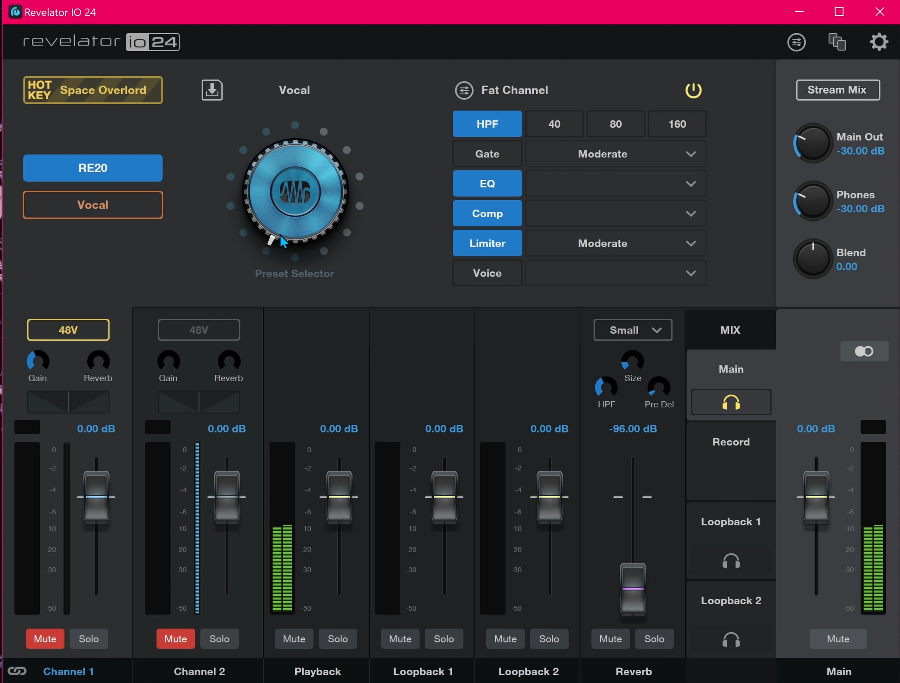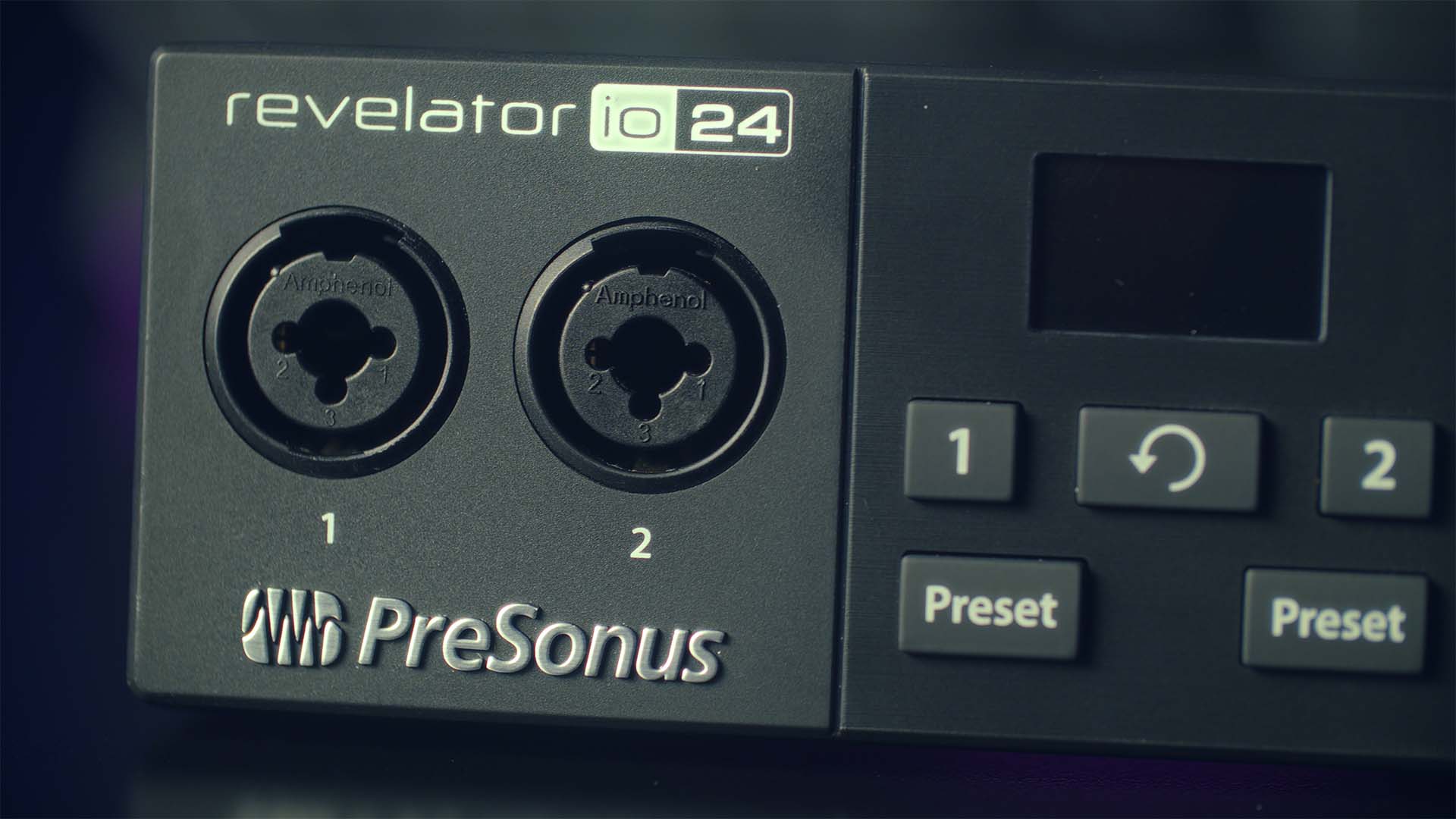PRODUCT LINKS (affiliate):
- PreSonus Revelator io24 on B&H – https://bhpho.to/3sMAaSZ
- PreSonus Revelator io24 on Amazon – https://geni.us/wmo2fsr
- PreSonus Revelator io24 on Sweetwater – https://imp.i114863.net/9WJy65
For certain streamer-focused use cases, the GoXLR may as well have been the PERFECT product, but it did have issues and wasn’t perfect for all workflows. We’ve seen competition slowly start to rise as the AVerMedia Live Streamer NEXUS and Elgato Wave XLR released, and more are coming.
One release I wasn’t sure I’d love so much is this little guy right here, the PreSonus Revelator io24. This new audio interface is meant to be a badass multi-purpose USB interface for vocals, music, and creators of all kinds, but it actually seems to be perfect for my desk setup, too! This thing is the same price (or cheaper) as the GoXLR Mini, but much more powerful and competes with the full-size GoXLR in many respects.
A pair of XLR and quarter-inch jacks sit right on the front – already an upgrade over the other streamer-focused products for those doing content with either more than one speaker, or needing an extra hookup for an instrument. You also have a teeny tiny LCD screen, input configuration buttons, mute buttons, and a clickable dial for quick volume adjustment.
Around back you have a Kensington lock, USB type C, MIDI in and out, quarter-inch main outputs for running to speakers, studio monitors, or another mixer – THANK YOU PreSonus, finally someone doesn’t forget us speaker users – and a quarter-inch headphone jack. I would have preferred the headphone jack up front and XLR on the back, but this is fine. I have this hooked up to my PreSonus Eris 5″ studio monitor speakers, funny enough.

The XLR pre-amps provide 60dB of gain – which appear to be enough for the ElectroVoice RE20, though the Shure SM7b seems to still need a mic activator to sound its best here – and 48V of phantom power is also available.
The headphone amp works with an impedance range of 32 to 300 ohm, so it should work with most headphones but perhaps not all crazy high-impedance ones.
The cool wizardry is the internal DSP. Yes, much like the GoXLR – and unlike the Wave XLR or Blue’s mic effects they’ve been adding to their microphones – the PreSonus Revelator io24 seems to have a pretty beefy DSP – or digital signal processor – onboard. This not only gives you a variety of goofy voice effects, reverb, vocoder, etc. but also a proper “Fat channel” audio chain including a high-pass filter, noise gate, EQ, compressor, and limiter built-in.
And unlike the GoXLR’s super basic and limited graphical equalizer, I can actually achieve the sound I like because the main EQ mode is a proper parametric EQ with adjustable Q-width and everything! I was able to basically copy-paste my exact post-processing settings from Adobe Audition right in here and it matches up almost exactly. Previously this has only been possible with Reaplug VSTs and that only got close, not quite the same. And it’s all being processed in the box itself, not using CPU cycles, and not being limited to OBS or anything like that.
This, right here, was the deciding factor for me to swap from the GoXLR to the io24 for my main setup. As cool as the GoXLR is and for most people who aren’t obsessing over audio details, just making some tweaks in the GoXLR EQ is probably fine – I have ALWAYS had issues getting sound that I like out of its EQ, and felt its compressor left a lot to be desired.

The io24 gives a full proper Parametric Equalizer – OR a passive or vintage style one if desired – along with full normal compressor AND limiter controls. Plus you can change the order to have the EQ happen before the compressor or vice versa, which I LOVE.
The compressor also has 3 different modes: Standard, Tube, and FET which is more of a vintage hardware compressor style. I stuck with standard since it’s what I’m familiar with, but you can get more unique sound out of the different modes here.
The only thing really missing from this fat channel is a de-esser. I was disappointed to not see it here, but realistically I don’t struggle with it that much and can easily slap that on my OBS profile for a final “safety pass” in my recordings and streams, while it won’t be necessary for voice calls or anything like that. Not a huge deal, even if disappointing.
The Revelator io24 also gives you sub-mixing, which the GoXLR does not. You have a main monitor mix for your headphones, and a separate stream or recording mix. You can also link your stream mix to your monitor mix if you don’t want it, or swap your headphones to any of the mixes.
There’s also 2 loopback submixes that I haven’t entirely figured out yet. This will only be part 1 of my adventure with this interface, get subscribed for a part 2 where I provide a proper “tutorial” once I’ve figured it out.
I dislike that I can only move my headphones to the different submixes and not the speakers, but I understand why it works that way. What’s really cool here is the main outputs could actually be paired with a bigger mixer for a proper mixing experience. I could just use the io24 as my interface and mic processor and then route it through my big SoundCraft mixer to get full mix controls and outputs to my headphones and speakers with more granular control.
Headphone volume, main volume, and monitor-playback blend can be adjusted with the dial on the front of the interface.
The mixing outputs can be a little confusing, as you have output devices in Windows for the Main output, then the two loopback devices. These loopback devices can also be sent to other applications to pair program audio with your mic audio. This is useful for programs that only let you record one audio device at a time, or looping relevant audio back to podcast guests over Zoom, etc.
I find the overall UI for this software a little confusing, actually. It has been frustrating at various points trying to get the right settings. Be it the confusing mix UI, the difference between the individual effects in the fat channel being enabled vs the whole fat channel being disabled, or the big preset knob that doesn’t save your settings if you turn it and generally sucks to use as most screen dials do. The GoXLR got a huge thing right with their routing table, and I hope to see other programs learn from it in time. Also on-screen dials never provide a good user experience, especially when I’m just selecting presets which would work fine as a list.
This little box is a small chunk of the footprint of the GoXLR, has a much better processing chain for making your mic sound better and cleaner, has higher-quality audio recording overall, and allows for two mics. The only thing it’s missing is the sampler – which is whatever and there are alternatives for – and I guess the physical faders. The physical faders will be slightly missed, but I know plenty of people don’t actually use them at all. And a later upgrade to the PCPanel Pro could be a more universally-compatible pairing to use to control specific application audio anyway.
The io24 isn’t quite as compelling if you’re a streamer that uses multiple PCs or a game console, due to the lack of auxiliary and optical inputs. For single PC streaming or non-game streaming, this could be a lot better, though. And again, it almost seems most perfect to pair with a basic mixer that perhaps isn’t great for your raw mic audio.
For $200, you’re getting a box that strongly competes with the GoXLR and other devices, but has a slightly different target use case. The parametric EQ immediately saves me a ton of time and frustration was an easy switching choice, and I may eventually set up my mixer again to make up for any mixing deficits here, but I’m not sure it’s even needed.
I haven’t given this out in a while, but this interface is the latest product to receive the official “Stream Professor Approved” badge. The value per cost, and efficacy of features makes it one of my top recommendations for streamers and content creators today.

